A Comprehensive Exploration of Pheasants in Nature
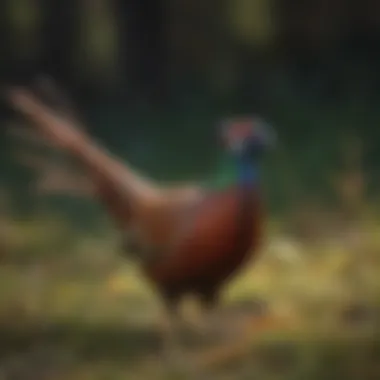
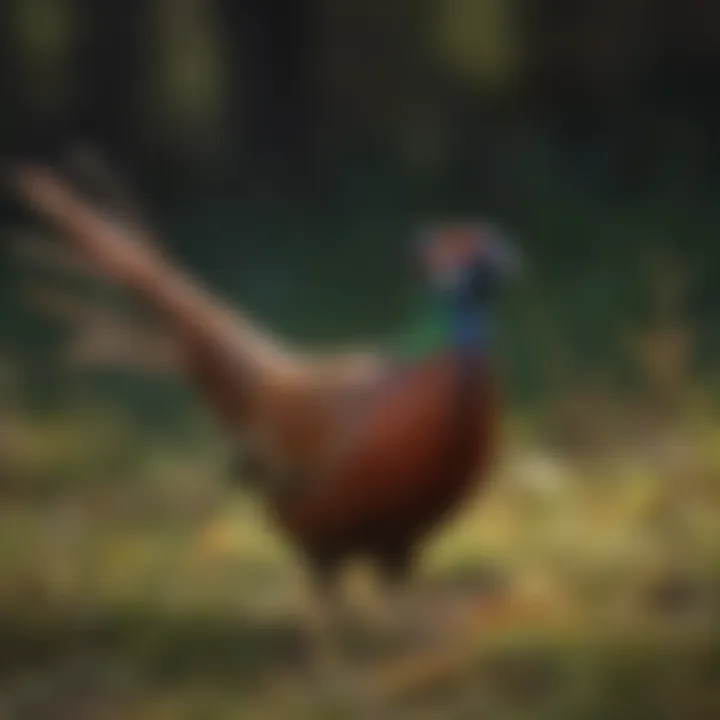
Intro
Pheasants are a captivating family of birds that inhabit various regions across the globe. They belong to the Phasianidae family, which includes several genera and species. There is a diverse range of pheasant types, each exhibiting unique behavioral patterns and physical characteristics. This article aims to uncover the rich tapestry of pheasant biology, behavior, habitat, and the crucial role they play in their ecosystems.
Understanding pheasants goes beyond just appreciating their beauty. It involves recognizing their importance in biodiversity, and their interactions within ecosystems. Their adaptive traits have allowed them to thrive in different environments, from grasslands to forests. However, human activities have led to significant impacts on their populations, threatening their existence in many regions.
Throughout this exploration, we will synthesize findings from scientific literature and research to provide a comprehensive perspective on pheasants in the context of wildlife conservation. By employing a detailed approach, we aim to educate our readers—students, researchers, and educators alike—on the multifaceted aspects of these intriguing birds.
Intro to Pheasants
Pheasants are a group of birds belonging to the family Phasianidae. They play a vital role in their ecosystems and are recognized for their striking appearance and varied behaviors. Understanding pheasants is crucial not only for ornithologists but also for ecologists, conservationists, and the general public interested in wildlife.
The importance of this topic lies in the multifaceted contributions of pheasants to biodiversity. They act as prey for numerous predators, thereby sustaining the food web. Also, they have unique social behaviors and mating rituals, which reflect evolutionary adaptations in response to environmental pressures. The study of pheasants can provide insights into avian ecology, including habitat preferences and feeding strategies.
In this section, we will explore several specific elements related to pheasants, including their ecological and cultural significance, and their adaptability in diverse habitats. Understanding these factors can foster a deeper appreciation for wildlife and promote efforts toward conservation.
Firstly, pheasants are notable for their vibrant plumage, which not only serves a role in attracting mates but also in camouflage. This visual aspect has garnered the interest of both biologists and the public, as it showcases the incredible diversity of traits in the animal kingdom.
Additionally, pheasants have a significant cultural impact. They have been a part of various traditions and histories around the world, influencing hunting practices and leisure activities. Their representation in art and literature further reinforces their importance in human history.
Lastly, as habitats are threatened by urban development and agriculture, understanding the challenges faced by pheasant populations becomes paramount. Highlighting their plight can amplify conservation efforts, prompting more strategic and informed approaches to preserving these birds and their environment.
In summary, the study of pheasants is not merely about understanding a single species; it can offer broader insights into ecological interactions, cultural dynamics, and the necessary steps for effective conservation. Therefore, delving into the world of these birds will reveal the interconnectedness of wildlife and the human experience, enriching our understanding of the natural world.
Taxonomy and Classification
Understanding the taxonomy and classification of pheasants is essential for several reasons. First, proper classification helps in identifying and categorizing the diverse species within the Phasianidae family. This understanding is crucial for conservation efforts and habitat protection. Furthermore, taxonomy provides insights into the evolutionary relationships among species, informing studies on biodiversity and ecology. By analyzing the taxonomy, researchers can also track how species adapt to environmental changes and the implications of human activities on their survival.
Overview of Phasianidae Family
The Phasianidae family encompasses a wide variety of birds, primarily found in the temperate and tropical regions of Asia, Europe, and North America. This family includes not only pheasants but also partridges, peacocks, and quails. Pheasants are characterized by their stout bodies, long tails, and sexually dimorphic plumage.
Some key attributes of the Phasianidae family include:
- Diversity: The family contains over 50 species, with variations in size, color, and behavior.
- Adaptation: Members of this family have developed various adaptations to thrive in their specific environments, from grasslands to dense forests.
- Behavioral traits: Understanding these species helps in revealing unique mating and social behaviors, critical for ecological studies.
Common Species of Pheasants
There are several well-known species of pheasants, each possessing distinct characteristics and behaviors. Some common species include:
- Common Pheasant (Phasianus colchicus): Known for its vibrant colors and widespread distribution, this species is often found in agricultural and open habitats. It has been widely introduced outside its native range.
- Golden Pheasant (Chrysolophus pictus): Native to mountain forests in China, this bird is recognizable by its striking yellow and red plumage, which appeals to aviculturists and bird enthusiasts alike.
- Lady Amherst's Pheasant (Chrysolophus amherstiae): This species showcases brilliant coloration and impressive tail feathers. It exists mainly in the forest floors of central China.
- Blue Pheasant (Phasianus wallichii): Recognized for its deep blue hues, this pheasant inhabits the mountainous regions of eastern Tibet and parts of China.
Each of these species exemplifies how environmental conditions shape their physical attributes and behaviors. By studying these pheasants, researchers gain valuable insights into the ecological roles they play, as well as the challenges they face due to habitat loss and hunting pressures.
Physical Characteristics
Understanding the physical characteristics of pheasants is essential to grasp their adaptations and behaviors within their habitat. These traits not only contribute to their survival in the wild but also influence their interactions with humans and other species. Physical characteristics include size, plumage, and sexual dimorphism, which play critical roles in the species’ reproductive success and environmental resilience. Each of these elements provides insight into how pheasants navigate their ecosystems and adapt to changing conditions.
Size and Plumage
Pheasants vary significantly in size, with most species exhibiting a range of body lengths from 45 to 80 centimeters. Weight can fluctuate widely depending on the species, where some can weigh as little as 500 grams while others exceed 3 kilograms. This size variation is vital for their survival, as it can influence their ability to evade predators and compete for food resources. The body shape and weight also affect their flight capabilities; larger pheasants tend to be less agile but can cover greater distances in a single flight.
Plumage in pheasants is particularly striking and serves various functional purposes. The vibrant colors and patterns found in many species are not merely for aesthetics; they play crucial roles in mating displays and camouflage. Males typically exhibit brighter and more elaborate plumage compared to females. This sexual dimorphism is significant during the breeding season, where males display their feathers to attract potential mates. For example, the male Phasianus colchicus, or common pheasant, is known for its golden-yellow, iridescent neck and intricate tail, making it a prominent figure in its territory.
Furthermore, the plumage undergoes seasonal changes that can help with camouflage, especially in environments with seasonal variations. In winter, some species may develop duller feathers to blend with the snowy landscapes, reducing visibility to predators.
Sexual Dimorphism
Sexual dimorphism in pheasants is a fascinating area of study, as it reflects broader themes in evolutionary biology and ecology. In many species, males are often larger and more colorful than females. This difference assists in mate selection; females usually choose mates based on their physical appearance and display behaviors. Species like the Argus pheasant epitomize this with males showcasing extensive, elaborately patterned feathers during courtship rituals.
The pronounced differences go beyond mere appearance. Males often exhibit behaviors such as crowing and territorial displays which indicate their fitness to potential mates. Females, on the other hand, are generally more subdued, which aids in their ability to avoid predators while incubating eggs and caring for chicks.
This dimorphism not only highlights the evolutionary strategies different species adopt, but it also influences population dynamics and conservation efforts, as changes in male populations can have significant implications on mating patterns and genetic diversity.
The plumage of pheasants plays a critical role in mating displays and camouflage, demonstrating the complex interplay between appearance and survival.
Habitat and Distribution
Understanding the habitat and distribution of pheasants serves as a vital foundation for appreciating their ecology and behavior. The habitats where pheasants thrive are not mere backdrops; they are complex ecosystems that support their survival and define their interactions with other species. By examining the types of environments they occupy, one gains insights into the adaptations they have developed over time. Furthermore, mapping their geographical distribution reveals the impact of both natural and anthropogenic factors on their populations.
Natural Habitats of Pheasants
Pheasants inhabit a variety of natural environments, which are crucial for their foraging, nesting, and rearing young. Primarily, these birds prefer grasslands, woodlands, and agricultural fields. Each habitat offers unique resources and opportunities:
- Grasslands: These open spaces provide abundant cover for breeding and protection from predators. The dense grasses support their feeding habits.
- Woodlands: Forest edges and thickets offer shelter and a wide range of food sources, including seeds and insects.
- Agricultural Fields: Farming areas often mimic natural habitats, providing seeds and cover. This habitat type can be beneficial, but it also introduces risks due to pesticide use and habitat fragmentation.
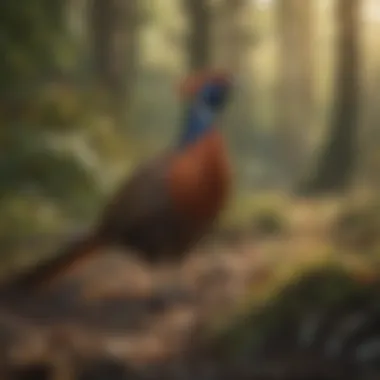
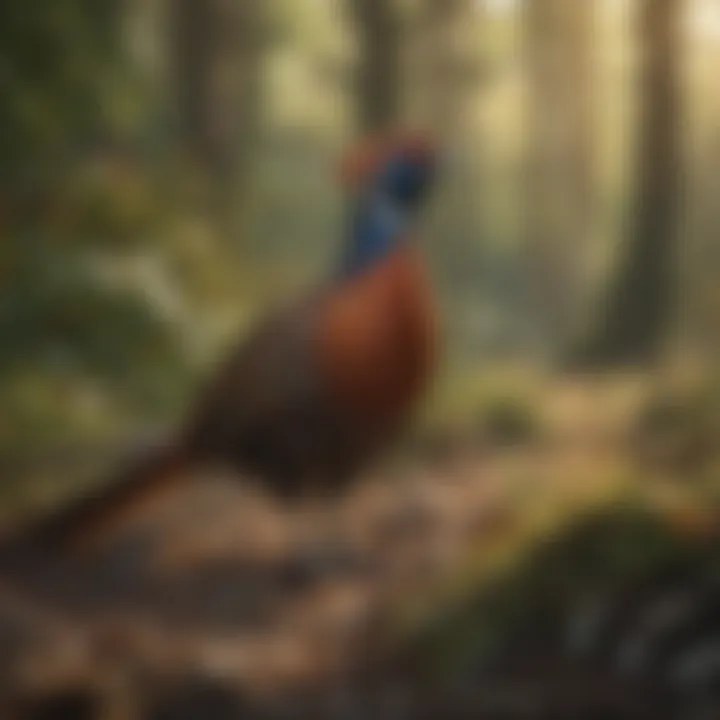
Pheasants are generally adaptable. They can thrive in altered landscapes as long as the essential components of their habitat are present. This adaptability, however, can lead to vulnerabilities when ideal conditions are scarce, or when human activity encroaches.
Geographical Distribution
Pheasants are found across a wide geographical range, mainly in Asia but extending to parts of Europe and North America due to introductions. The most notable species include the Common Pheasant, indigenous to Asia, and the Ring-necked Pheasant, which has been introduced to various regions worldwide. Their distribution is often influenced by their specific habitat needs and the ecological balance within those areas.
- Asia: This region serves as the cradle for many pheasant species. The interplay of varying climates and terrains supports diverse populations.
- North America: Here, the Ring-necked Pheasant is prevalent, having been introduced in the early 20th century. They are common in agricultural and grassland regions, demonstrating how adaptable they can be.
- Europe: Pheasants are also present in various parts of Europe, often in agricultural settings. Their introduction has changed local ecosystems, impacting native species.
In summary, habitat and distribution are essential aspects of pheasant biology. Their ability to adapt to different environments has facilitated their spread. Yet, it is crucial to remain aware of the conservation challenges arising from habitat loss and climate change, emphasizing the significance of protecting their natural habitats.
"Understanding the habitat requirements of pheasants aids not only in their conservation but also enhances ecologically balanced landscapes that benefit all species."
This overview of their habitat and distribution sheds light on the need for continual research and conservation efforts, ensuring that these remarkable birds continue to thrive.
Diet and Feeding Behavior
Diet and feeding behavior are critical aspects in understanding the overall ecology of pheasants. These behaviors not only influence their survival rates but also impact their role in the ecosystems they inhabit. Pheasants, as omnivores, display complex feeding strategies that allow them to adapt to a variety of habitats and available food sources. This section will discuss their dietary habits and foraging behaviors, showcasing the significant role these factors play in their life cycle and the environments they occupy.
Omnivorous Diet
Pheasants are classified as omnivores, meaning their diet consists of both plant and animal materials. This adaptability in diet is advantageous in fluctuating environments where food availability may change. Some typical components of a pheasant's diet include:
- Seeds and Grains: Pheasants often consume seeds and grains that they find on the ground, especially in agricultural areas. This makes them a common sight in fields.
- Insects and Larvae: During warmer months, insects become a significant part of their diet. Insects provide essential protein, which is crucial for growth, especially for young chicks.
- Fruits and Berries: Pheasants will also forage for fruits and berries when in season, adding variety to their diet.
- Plant Matter: They consume various green plant materials, which can provide necessary nutrients and fibers.
This diverse diet helps pheasants maintain good health and adapt to their surroundings effectively. It enables them to thrive in both rural and wild environments, ensuring they can find food regardless of seasonal changes.
Foraging Strategies
Pheasants employ various foraging strategies to efficiently locate and consume their food. These strategies vary based on their specific habitats, the availability of food, and the time of year. Key foraging strategies include:
- Ground Foraging: Pheasants often scavenge on the ground, scratching at the soil or leaf litter to uncover hidden seeds and insects.
- Visual Foraging: They primarily rely on their keen eyesight to spot food from a distance. This helps them avoid predators while locating their meals.
- Social Foraging: Sometimes, pheasants will forage in groups. This can enhance their safety as there are more eyes to detect threats, allowing them to focus on feeding.
- Seasonal Adjustment: Their foraging behavior can change with the seasons. In winter, they may rely more heavily on grains stored in fields, while in spring and summer, they may increase their intake of insects and greenery due to higher availability.
Adapting these foraging strategies allows pheasants to maximize their food intake efficiently. As they navigate through different habitats, their ability to adjust their feeding behavior plays a pivotal role in their ecological success.
Pheasants' dietary habits and foraging strategies significantly influence their survival and reproduction, emphasizing the need for understanding these behaviors in conservation efforts.
Through this examination, it becomes evident that the diet and feeding behavior of pheasants are not mere biological functions but rather integral components that support their ecological roles. Emphasizing their omnivorous nature and diverse foraging strategies sheds light on the importance of habitat preservation for their longevity.
Reproductive Behavior
Reproductive behavior is a crucial aspect of pheasant life. It determines their ability to sustain populations and adapt to changing environments. Understanding these behaviors offers insights into their natural history and ecological significance. Information about mating rituals, nesting practices, and parental care illustrates how pheasants interact with their environment and each other during reproduction. This section details the specific mating habits, the significance of nesting locations, and incubation practices.
Mating Habits
Pheasants exhibit a variety of mating habits that are often dictated by species and environmental conditions. Males are typically known for their elaborate courtship displays. These displays might include vocalizations, feather displays, and physical posturing. The purpose of these displays is to attract females and establish dominance over other males.
During the mating season, which usually coincides with spring, males become more aggressive. They will establish and defend territories that they mark with calls and visual signals. This area often serves as a stage for courtship displays. Female pheasants will assess males based on these performances, often choosing mates that exhibit the most impressive traits or displays. Basic points about mating habits include:
- Males engage in aggressive behavior to establish dominance.
- Courtship displays involve vocalizations and physical performances.
- Females select mates based on display effectiveness and territory quality.
Nesting and Incubation
Nesting behavior is another essential part of pheasant reproduction. Females typically search for concealed locations to lay their eggs. This is crucial for minimizing predation risks. Choices for nesting sites vary from dense grasslands to shrub thickets, depending on habitat availability.
A female will lay an average of 10 to 15 eggs, usually in a shallow depression lined with grasses and feathers. The eggs are often camouflaged to blend in with the surroundings, providing yet another layer of protection.
Once the eggs are laid, the female begins the incubation process, which lasts about three weeks. Unlike many birds, males usually do not play a role in incubation. Instead, they remain vigilant, watching over the territory. Here are key factors to consider regarding nesting and incubation:
- Nesting locations are chosen based on safety from predators.
- The average clutch size is between 10 to 15 eggs.
- Incubation is primarily the responsibility of the female, lasting around three weeks.
The reproductive behaviors of pheasants not only reflect their biological needs but also highlight their interactions and adaptations within ecosystems.
Understanding these reproductive strategies can inform conservation efforts, helping to maintain healthy pheasant populations and their ecosystems.
Behavioral Patterns
Understanding behavioral patterns in pheasants is crucial for those studying wildlife and ecology. These patterns reveal how pheasants interact with their environment and other species, which has significant implications for their survival and ecological roles. By examining social structures and communication strategies, we gain insights into pheasant behavior that can inform conservation efforts and habitat management.
Social Structure
The social structure of pheasants plays a vital role in their behavior and survival. Generally structured in loose flocks, these birds exhibit a hierarchy that can influence access to food and mating opportunities. Males often establish dominance through displays of plumage and vocalizations, engaging in elaborate rituals to assert their strength and attract female partners.
- Flock Composition: Pheasant flocks typically include a mixture of males and females. Seasonal variations can occur, particularly during breeding season when males become more territorial.
- Hierarchy and Dominance: Dominant males often enjoy greater access to resources, impacting the overall fitness of subordinate individuals.
- Group Benefits: Social living offers advantages such as increased vigilance against predators. Flocking behavior enhances survival probabilities.
Territoriality and Communication
Territoriality is a defining aspect of pheasant behavior, especially during the breeding season. Males establish and defend territories where they can court females and access food resources. This behavior consists of vocalizations, physical displays, and scent marking.


- Vocal Communication: Pheasants are vocal birds, utilizing a range of calls for different purposes. These can include alerts, mating calls, and warnings. Understanding their vocalizations helps in recognizing their activities and behaviors in different contexts.
- Physical Displays: Displays of plumage such as puffing up, bowing, and tail spreading are crucial in attracting mates and warding off competitors. Such behaviors directly impact reproductive success.
- Territorial Markings: Pheasants may use scent to mark their territories, establishing boundaries with olfactory cues to warn off intruders.
"Understanding the social structure and territoriality of pheasants is essential for effective management and conservation strategies. Such knowledge aids in preserving their habitats and maintaining ecological balance."
These behavioral patterns reveal the complexities of pheasant societies and highlight their importance within ecosystems. The interplay of social dynamics and communication not only governs their interactions but also their roles within the environmental context they inhabit.
Pheasants in Ecosystems
Pheasants play a significant role in various ecosystems. They are not just beautiful birds; their presence indicates a healthy environment. The significance of pheasants in ecosystems can be divided into two main areas: their role in food webs and their impact on biodiversity. Each of these elements provides insight into how pheasants contribute to ecological balance.
Role in Food Webs
Pheasants serve as both prey and predators in their ecosystem. As omnivores, they consume a wide range of foods including seeds, insects, and small animals. This diverse diet allows them to thrive in different habitats and significantly influences the dynamics of the food web.
- Prey Species: Pheasants are hunted by numerous predators, including foxes, hawks, and raccoons. Their presence provides sustenance to these animals, supporting the local wildlife population.
- Seed Dispersal: While feeding on plants, pheasants help in seed dispersal. They pass through undigested seeds, which can germinate elsewhere, aiding in plant reproduction and diversity.
This dual role enhances the stability of ecosystems by sustaining both the plant and animal communities.
Impact on Biodiversity
Biodiversity is essential for healthy ecosystems, and pheasants contribute to this through various means. Their foraging habits affect soil health and plant populations. Additionally, they facilitate a habitat that supports other species.
- Habitat Creation: Pheasants create discontinuities in vegetation through their feeding. This interaction can promote different plant growth, creating varied microhabitats for other species.
- Genetic Diversity: The diverse genetic makeup within pheasant populations can provide resilience to environmental changes and diseases, making them valuable in maintaining overall biodiversity.
"Pheasants are an integral part of the ecosystems they inhabit, influencing both food webs and contributing to the rich tapestry of biodiversity."
Ultimately, the ecological roles that pheasants play highlight their importance beyond mere beauty. Their existence impacts and reflects the intricacies of the ecosystems they are part of.
Conservation Status
Conservation status is a critical aspect of understanding the future of pheasants and their habitats. It reflects the health of populations and ecosystems. Evaluating conservation status helps to pinpoint what measures need to be taken to protect these birds. This section examines various factors that threaten pheasant populations, as well as the ongoing efforts to preserve them.
Threats to Pheasant Populations
Pheasant populations face numerous threats, many of which stem from human activity. The primary factors include:
- Habitat Loss: Urbanization, agriculture, and deforestation have significantly reduced available habitats for pheasants. Land conversion limits food sources and nesting sites.
- Pesticides and Herbicides: Chemicals used in farming negatively affect pheasants. These substances can poison pheasants directly or reduce their food supply by killing insects and plant species they rely on.
- Hunting Pressure: While regulated hunting can be sustainable, excessive hunting can lead to population declines, especially if breeding populations are affected.
- Climate Change: Changes in temperature and precipitation patterns disrupt pheasant habitats and their breeding cycles, making it harder for them to survive and reproduce.
The combination of these threats can create a challenging environment for pheasants. Declines in populations often result in increased vulnerability to further risks, making effective conservation efforts essential.
Conservation Efforts
Various conservation efforts are underway globally to safeguard pheasants. These initiatives focus on multiple levels, from habitat restoration to public education and policy changes. Key strategies include:
- Habitat Restoration: Many organizations are engaged in restoring wetlands, grasslands, and forests. This restores the natural environment for pheasants, increasing both habitat quality and connectivity.
- Sustainable Agricultural Practices: Encouraging farmers to adopt ecologically friendly practices can reduce pesticide use, promoting a healthier ecosystem.
- Regulation of Hunting: Managing hunting seasons and quotas to ensure sustainable populations protects breeding pheasant groups.
- Education and Public Involvement: Initiatives to raise awareness about pheasants help foster community participation in conservation programs. Educating people about the role of pheasants in ecosystems encourages local support.
"Conservation of pheasants is not just about saving a species; it is about maintaining the integrity of the ecosystems they inhabit."
Ultimately, these conservation efforts aim not only to protect physical populations of pheasants but also to maintain the biodiversity of ecosystems where they play an integral role. By addressing the underlying threats and promoting adaptive strategies, such initiatives lay the groundwork for future resilience.
Cultural Significance
Cultural significance of pheasants extends beyond mere aesthetic appreciation. These birds have been intertwined with human narratives for centuries. They serve important roles in folklore, cuisine, and hunting traditions, reflecting the community's relationship with nature. Understanding this cultural context helps to appreciate their value beyond ecological contributions.
Pheasants in Human History
Pheasants have a long and complex relationship with humans. Historically, these birds have been associated with nobility and opulence. The domestication of species like the common pheasant, Phasianus colchicus, can be traced back to ancient times in Asia. They were prized for their colorful plumage and were often depicted in art and literature.
In medieval Europe, pheasant hunting became a sport among the aristocracy. The practice was not merely for consumption but served as a symbol of status and power. As hunting techniques evolved, pheasants were maintained in controlled habitats, aimed at sustaining populations for sport.
Moreover, many cultures developed rituals and belief systems around pheasants. In parts of Asia, these birds are revered within various spiritual practices, symbolizing prosperity and good fortune.
Symbolism and Representation
Pheasants have strong symbolic meanings across cultures. In Chinese culture, they symbolize fidelity and elegance. This is often reflected in poetry and art, where the pheasant represents virtues such as honor and respect. Their vivid colors and unique patterns have made them subjects of artistic representation.
In Western contexts, pheasants often represent nature's bounty and are associated with rural life. They are seen in literature as symbols of grace, beauty, and the cyclicality of life. Furthermore, their presence in various local cultures often signifies a connection to the land and traditions of habitat conservation.
"Pheasants are not just birds; they are a part of human narrative, a bridge between nature and culture."
Economic Importance
The economic significance of pheasants extends beyond mere aesthetic appeal. They play pivotal roles in agriculture, eco-tourism, and sustainable hunting practices, making them essential for both local and global economies. Understanding the economic aspects of pheasants helps inform conservation strategies and agricultural practices.
Pheasant Hunting and Agriculture
Pheasant hunting is a time-honored tradition in many regions, significantly contributing to local economies. This activity generates revenue through licenses, permits, and related services. In the United States, for instance, pheasant hunting attracts thousands of hunters each year, which supports local businesses, including restaurants, hotels, and sporting goods stores.
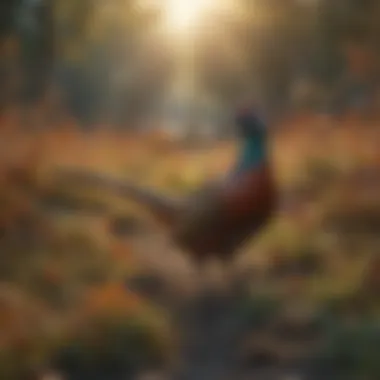
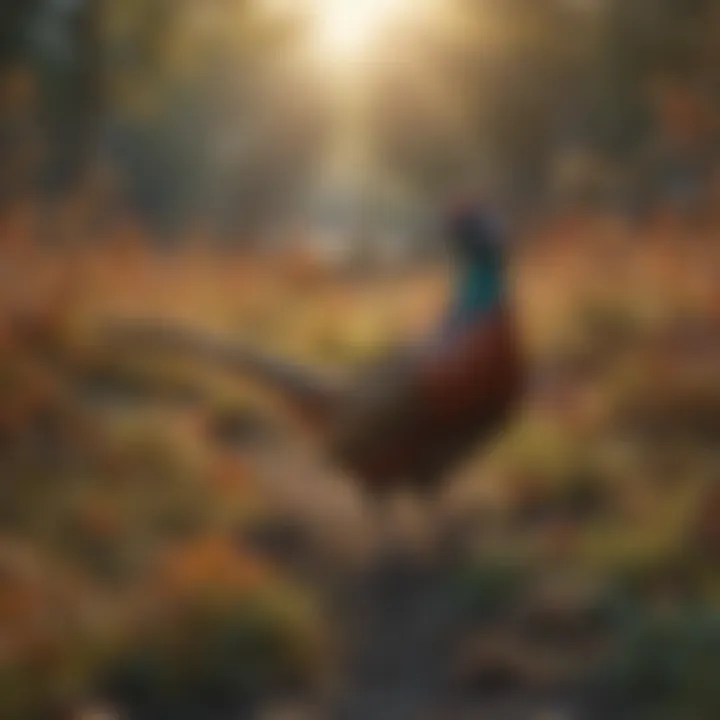
Additionally, pheasants are often raised in agricultural settings. Their introduction helps control pest populations, reducing the need for chemical pesticides and promoting healthier ecosystems. Farmers benefit from these birds through natural pest management solutions while enjoying the added income from hunting and aviculture.
Pheasants can also be part of wildlife corridors on farms, enhancing biodiversity. By integrating pheasant-friendly habitats within agricultural landscapes, farmers create ecological networks that benefit various species, fostering resilience to environmental changes. This integration leads to long-term sustainability in both farming practices and wildlife conservation.
Pheasants in Aviculture
The aviculture industry, focusing on the breeding and keeping of birds, has seen a noticeable interest in pheasants. Enthusiasts seek various pheasant species for their unique traits and ornamental value. This demand can boost local economies, as specialty breeders and aviculture businesses respond to the needs of hobbyists and collectors.
Furthermore, pheasants in aviculture often serve as educational tools. Schools and conservation organizations utilize them to teach about biodiversity, ecology, and conservation practices. The presence of pheasants in such educational programs raises awareness about wildlife protection, encouraging more responsible behaviors toward nature.
"Understanding the economic significance of pheasants is key to balancing their conservation with agricultural needs."
Research and Studies
Research on pheasants offers crucial insights into their ecology, behavior, and conservation needs. Understanding how pheasants interact with their environment aids in implementing effective conservation strategies. This topic is significant because it highlights the complexities of pheasant biology while drawing attention to the impacts of human activities. Knowledge gained from research also informs policies that are essential for preserving these birds and their habitats.
Additionally, studies related to pheasants are vital for understanding broader ecological dynamics. Pheasants are integral to many ecosystems, and research helps clarify their role within food webs and their interactions with other wildlife. By studying pheasants, researchers can gather data that contributes to conservation science and biodiversity management.
Current Research Trends
Current trends in pheasant research focus on various aspects that directly impact their populations and habitats. Some notable trends include:
- Genetic Studies: These analyses assess the genetic diversity within pheasant populations, crucial for understanding their resilience to environmental changes and diseases.
- Behavioral Ecology: Studies examine how pheasants adapt their behavior in response to habitat alterations, predation pressures, and climatic variations.
- Conservation Genetics: This field investigates the genetic health of isolated pheasant populations, seeking to identify strategies for maintaining genetic diversity.
Moreover, researchers are increasingly using technology, such as GPS tracking, to monitor pheasant movements and habitat use. This data is invaluable for designing effective conservation measures and habitat management practices, ensuring the long-term survival of these species in the wild.
Significant Findings
Significant findings in pheasant research illustrate the challenges these birds face and the effectiveness of conservation efforts. Some key findings include:
- Population Declines: Many studies report alarming declines in pheasant populations due to habitat loss and fragmentation caused by agricultural expansion and urban development.
- Impact of Climate Change: Research shows that changes in climate patterns affect pheasant breeding success. Alterations in temperature and precipitation not only impact food availability but also the timing of reproductive cycles.
- Conservation Impact: Evidence indicates that well-implemented habitat restoration projects lead to positive outcomes for pheasant populations, as they promote breeding and improve survival rates.
Understanding these findings is critical for wildlife specialists and policymakers in their efforts to protect pheasant species and enhance biodiversity.
In summary, continued research on pheasants will greatly influence conservation strategies and ecological understanding. Such insights are not just theoretical; they have practical implications in the field, enhancing our ability to safeguard this vital component of our natural world.
Future Directions in Pheasant Research
Research on pheasants has evolved significantly. It now encompasses diverse areas including genetics, behavior, and ecology. Understanding these aspects can guide conservation efforts and inform wildlife management practices. Exploring future directions in pheasant research is essential to address the challenges posed by changing environments and human activities.
Emerging Areas of Interest
Researchers are increasingly focusing on genetic diversity among pheasant populations. This is vital to ensure their adaptability to environmental changes. Recent studies suggest that gene flow between populations can enhance resilience against diseases. Evaluating genetic markers could help identify unique populations and prioritize them for conservation.
Another area gaining traction is the impact of climate change on pheasant habitats. As temperatures rise and weather patterns shift, habitats may alter. Understanding how these changes affect pheasant distribution and breeding patterns is crucial. Studies that model these scenarios can provide insights into potential habitat loss.
Additionally, behavioral research is key to comprehending how pheasants interact with their environment. This includes studying their responses to habitat destruction and fragmentation. Investigating their social structures can reveal adaptations to changes in their ecosystems. More research is needed on how human presence alters their natural behavior.
Conservation Strategies Moving Forward
Implementing effective conservation strategies requires a multifaceted approach. First, habitat restoration must be prioritized. Identifying critical areas for pheasant populations can help maintain biodiversity. Engaging local communities in restoration efforts ensures that conservation practices are sustainable and culturally accepted.
Furthermore, collaboration across borders is vital for effective conservation. Many pheasant species migrate or overlap in range with other species. International partnerships can facilitate the sharing of knowledge and resources. This could lead to more comprehensive conservation strategies.
Monitoring and research must go hand in hand. Continuous assessment of pheasant populations enables conservationists to adjust their strategies based on data. Utilizing modern technologies like GPS tracking can enhance data collection on movement patterns and habitat use.
"To ensure the longevity of pheasant populations, it is essential to invest in both research and conservation strategies that address the complexities of their ecosystems." - Wildlife Conservation Expert
This composite understanding is crucial for various stakeholders, from wildlife managers to policy-makers, aiming for a sustainable future for pheasants.
Summary and Ends
In summarizing the complex world of pheasants, it is crucial to recognize their multifaceted role within ecosystems. Pheasants are not simply vibrant, ornamental birds; they are integral components of their habitats, contributing to both ecological balance and human culture.
This article has explored various dimensions of pheasant life, including taxonomy, physical traits, and reproductive behavior. Each aspect reveals important details on how these birds survive and thrive in diverse environments. The sections on their diets and foraging strategies underline their adaptability, while discussions about habitat distribution emphasize the delicate balance they maintain with their surroundings.
The significance of pheasants extends beyond biology; they impact ecosystems significantly. Understanding their role in food webs and biodiversity highlights their importance as indicators of environmental health. The threats they face, which include habitat loss and climate change, make it imperative for conservation efforts to be prioritized. The discussions on conservation strategies present real action pathways to ensure pheasant populations remain stable.
Culturally, pheasants have been prominent throughout human history, symbolizing wealth and beauty in various societies. This connection to culture underscores the need for continued research in order to advocate for their conservation while respecting the human aspects linked to them.
Future research directions should focus on emerging areas of interest, such as genetic diversity and the role of urbanization on pheasant populations. These studies will not only enrich our understanding but also guide more effective conservation strategies moving forward.
Ultimately, a comprehensive understanding of pheasants, their challenges, and their significance fosters a deeper appreciation for wildlife conservation. Maintaining their populations is not just about preserving a species; it is about sustaining the ecological and cultural fabric that weaves through our lives. The information provided herein serves as a vital resource for students, researchers, and conservationists alike, offering insights that may help inform their future work and initiatives.
Importance of References in this Article
- Credibility: Accurate references solidify the reliability of the content. They help in substantiating the claims made throughout the article. This is particularly essential for those in academic or professional settings, where verifiable data is critical to informed decisions.
- Further Reading: By listing reputable sources, readers are encouraged to delve deeper into particular areas of interest. This can lead to greater understanding and exploration of pheasants' behavior, habitat, and ecological roles, driving a more informed perspective.
- Awareness of Current Research: References often include recent studies and findings. This helps keep the audience updated on the latest trends in pheasant research, encouraging engagement with ongoing scholarly conversations.
- Interdisciplinary Context: The inclusion of references from various disciplines, such as ecology and conservation, bridges multiple fields of study. This helps readers appreciate the broader implications of pheasant conservation within environmental science and biodiversity.
Specific Elements to Consider
- Academic Journals: Referencing peer-reviewed articles illuminates the findings of established researchers. Journals like Journal of Wildlife Management or Ecological Applications serve as prime examples.
- Books: Comprehensive texts on ornithology and conservation can provide insight into global pheasant species, their ecology, and conservation strategies.
- Online Resources: Websites like en.wikipedia.org and britannica.com provide summarized information that can be useful for those new to the topic, alongside links to original research sources.
"Knowledge, especially in the realm of biodiversity and conservation, is built on the echoes of past research. The references guide your journey through this vast landscape."







